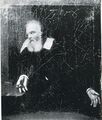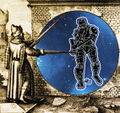Template:Selected anniversaries/August 25: Difference between revisions
No edit summary |
No edit summary |
||
| Line 1: | Line 1: | ||
<gallery> | <gallery> | ||
||79: Pliny the Elder dies ... Roman scholar and author of the celebrated Natural History, in 37 volumes an encyclopaedic work of very uneven accuracy that was nonetheless an authority on scientific matters up to the Middle Ages. He prepared this as a digest of two thousand ancient books written by nearly five hundred writers. He was mostly undiscriminating regarding the accuracy of the content. Though he rejected, for example, the possibility of immortality, he also rejected Pytheas' valid theory that the moon was responsible for tides. Correctly, he accepted the spherical form of the Earth. As another example, he included various theories on the origin of amber, one correct among others fanciful and wrong. The book dealt in subjects ranging from astronomy, geography, and zoology. He died in the eruption of Vesuvius, too anxious to witness the event to retreat from the ashes and toxic gases. | ||79: Pliny the Elder dies ... Roman scholar and author of the celebrated Natural History, in 37 volumes an encyclopaedic work of very uneven accuracy that was nonetheless an authority on scientific matters up to the Middle Ages. He prepared this as a digest of two thousand ancient books written by nearly five hundred writers. He was mostly undiscriminating regarding the accuracy of the content. Though he rejected, for example, the possibility of immortality, he also rejected Pytheas' valid theory that the moon was responsible for tides. Correctly, he accepted the spherical form of the Earth. As another example, he included various theories on the origin of amber, one correct among others fanciful and wrong. The book dealt in subjects ranging from astronomy, geography, and zoology. He died in the eruption of Vesuvius, too anxious to witness the event to retreat from the ashes and toxic gases. Pics (imagined; no contemporary portrait survives). | ||
||1561: Philippe van Lansberge born ... astronomer and mathematician. | ||1561: Philippe van Lansberge born ... astronomer and mathematician. Pic. | ||
File:Galileo E pur si muove.jpg|link=Galileo Galilei (nonfiction)|1609: [[Galileo Galilei (nonfiction)|Galileo Galilei]] demonstrates his first telescope to Venetian lawmakers. | File:Galileo E pur si muove.jpg|link=Galileo Galilei (nonfiction)|1609: [[Galileo Galilei (nonfiction)|Galileo Galilei]] demonstrates his first telescope to Venetian lawmakers. | ||
| Line 80: | Line 80: | ||
||1981: Voyager II comes within 63,000 miles (100,000 km) of Saturn’s cloud cover, sending back data and pictures of the ringed planet in its closest approach to Saturn, showing not a few, but thousands of rings. Photographs were also sent back of a number of Saturn's moons. The space probe was launched on 20 Aug 1977, and visited Jupiter on 9 Jul 1979, and continued on to Uranus (24 Jan 1986) and Neptune (25 Aug 1989) before leaving the Solar System. Having a nuclear power source, the space probe continues to study ultraviolet sources among the stars, and its fields and particles instruments continue to search for the boundary between the Sun's influence and interstellar space. | ||1981: Voyager II comes within 63,000 miles (100,000 km) of Saturn’s cloud cover, sending back data and pictures of the ringed planet in its closest approach to Saturn, showing not a few, but thousands of rings. Photographs were also sent back of a number of Saturn's moons. The space probe was launched on 20 Aug 1977, and visited Jupiter on 9 Jul 1979, and continued on to Uranus (24 Jan 1986) and Neptune (25 Aug 1989) before leaving the Solar System. Having a nuclear power source, the space probe continues to study ultraviolet sources among the stars, and its fields and particles instruments continue to search for the boundary between the Sun's influence and interstellar space. | ||
||1986: Milton Stanley Livingston dies ... accelerator physicist, co-inventor of the cyclotron with Ernest Lawrence, and co-discoverer with Ernest Courant and Hartland Snyder of the strong focusing principle, which allowed development of modern large-scale particle accelerators. | ||1986: Milton Stanley Livingston dies ... accelerator physicist, co-inventor of the cyclotron with Ernest Lawrence, and co-discoverer with Ernest Courant and Hartland Snyder of the strong focusing principle, which allowed development of modern large-scale particle accelerators. Pic. | ||
||1989: Jean-Louis Verdier dies ... mathematician who worked, under the guidance of Alexander Grothendieck, on derived categories and Verdier duality. Pic. | ||1989: Jean-Louis Verdier dies ... mathematician who worked, under the guidance of Alexander Grothendieck, on derived categories and Verdier duality. Pic. | ||
| Line 86: | Line 86: | ||
||1989: The Voyager 2 spacecraft makes its closest approach to Neptune and provided definitive proof of the existence of the planet's rings. | ||1989: The Voyager 2 spacecraft makes its closest approach to Neptune and provided definitive proof of the existence of the planet's rings. | ||
||1991: Linus Torvalds announces the first version of what will become Linux. | ||1991: Linus Torvalds announces the first version of what will become Linux. Pic. | ||
||2005: Ruth Aaronson Bari dies ... mathematician known for her work in graph theory and algebraic homomorphisms. Pic. | ||2005: Ruth Aaronson Bari dies ... mathematician known for her work in graph theory and algebraic homomorphisms. Pic. | ||
Revision as of 20:50, 23 February 2019
1609: Galileo Galilei demonstrates his first telescope to Venetian lawmakers.
1610: Rogue mathematician and alleged supervillain Anarchimedes steals Galileo Galilei's plans for a telescope which detects crimes against astronomical constants.
1698: Physicist, mathematician, and inventor Denis Papin demonstrates new version of his steam digester which uses Gnomon algorithm principles to generate gray light and cryptographic numina.
1699: Mathematician and mechanician Charles Étienne Louis Camus born. He will be the author of Cours de mathématiques (Paris, 1766), along with a number of essays on mathematical and mechanical subjects.
1818: Mechanical soldier Clock Head receives several patents for an improvements to steam engines.
1819: inventor, engineer, and chemist James Watt dies. He made major improvements to the steam engine.
1933: Clock Head 2 publishes new class of Gnomon algorithm functions which detect and prevent crimes against mathematical constants.
1934: Inventor Philo Farnsworth demonstrates his electronic television system to the public at the Franklin Institute in Philadelphia.
1948: The House Un-American Activities Committee holds first-ever televised congressional hearing: "Confrontation Day" between Whittaker Chambers and Alger Hiss.
2012: Voyager 1 crossed the heliopause to become the first spacecraft to enter interstellar space and study the interstellar medium.
2016: Polymath George Spencer-Brown dies. He wrote Laws of Form, calling it the "primary algebra" and the "calculus of indications".
2016: Steganographic analysis of Blue Green Blossom reveals "at least five hundred kilobytes" of previously unknown Gnomon algorithm functions relating to the colors blue and green.











